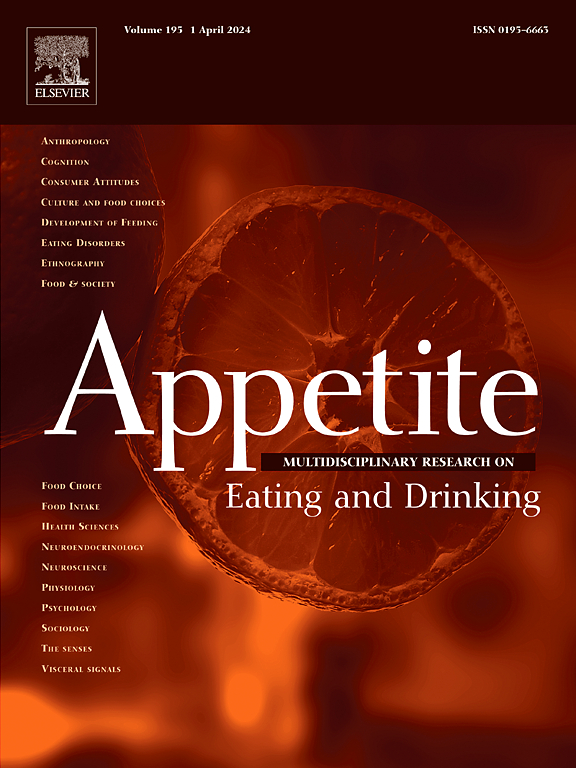Mothers’ perceptions of marketing elements on infant formula packages: A mixed-methods exploration in Uruguay
IF 3.8
2区 医学
Q1 BEHAVIORAL SCIENCES
引用次数: 0
Abstract
The marketing and commercialization of infant formula have been identified as major barriers to breastfeeding, influencing parental feeding choices through a wide range of strategies that include persuasive packaging elements. This work explores how mothers in Uruguay perceive infant formula packaging and examines the influence of marketing elements on their perceptions and behavioral intentions. An exploratory sequential mixed-methods design was employed, combining semi-structured interviews with a randomized controlled trial. The qualitative component (Study 1) involved interviews with 34 mothers in Uruguay, analyzing their perceptions of packages of three commercial infant formula. The quantitative component (Study 2) assessed the impact of marketing elements with 544 participants randomly assigned to five experimental conditions corresponding to packages designed following a stepwise reduction approach in the number of different marketing elements, progressively removing elements from a fully branded package to a plain version. Participants were asked to rate their degree of agreement with a series of statements. The qualitative findings revealed that a wide range of packaging elements, including material, graphic design, branding, and textual claims, captured mothers' attention and influenced their perceptions of infant formula. Despite the strong influence of packaging elements on perceptions, participants’ actual product choices were primarily determined by medical recommendations. Most participants responded more favorably to a commercial infant formula package with minimal marketing elements, whereas packages with prominent marketing claims were perceived as overly commercial and industrialized. The randomized controlled trial showed similar findings. The package featuring only a graphic design and brand logo was perceived more favorably than packages with extensive marketing claims, particularly among mothers who had previously used infant formula. Taken together, these results suggest that mandating plain packaging could further support informed decision-making.
母亲对婴儿配方奶粉包装营销要素的看法:乌拉圭混合方法的探索
婴儿配方奶粉的营销和商业化已被确定为母乳喂养的主要障碍,通过包括说服性包装元素在内的广泛战略影响父母的喂养选择。本研究探讨了乌拉圭的母亲如何看待婴儿配方奶粉包装,并考察了营销因素对其认知和行为意图的影响。采用探索性顺序混合方法设计,将半结构化访谈与随机对照试验相结合。定性部分(研究1)涉及对乌拉圭34位母亲的访谈,分析她们对三种商业婴儿配方奶粉包装的看法。定量成分(研究2)评估了营销元素的影响,544名参与者随机分配到五个实验条件中,这些条件对应于按照逐步减少不同营销元素数量的方法设计的包装,逐步从完全品牌的包装中删除元素到普通版本。参与者被要求评价他们对一系列陈述的同意程度。定性调查结果显示,包括材料、平面设计、品牌和文字声明在内的各种包装元素吸引了母亲的注意力,并影响了她们对婴儿配方奶粉的看法。尽管包装因素对认知有很大影响,但参与者的实际产品选择主要是由医疗建议决定的。大多数参与者对带有最少营销元素的商业婴儿配方奶粉包装反应更积极,而带有突出营销声明的包装则被认为过于商业化和工业化。随机对照试验也显示了类似的结果。只有图形设计和品牌标识的包装比有大量营销宣传的包装更受欢迎,特别是在以前使用过婴儿配方奶粉的母亲中。综上所述,这些结果表明,强制要求普通包装可以进一步支持明智的决策。
本文章由计算机程序翻译,如有差异,请以英文原文为准。
求助全文
约1分钟内获得全文
求助全文
来源期刊

Appetite
医学-行为科学
CiteScore
9.10
自引率
11.10%
发文量
566
审稿时长
13.4 weeks
期刊介绍:
Appetite is an international research journal specializing in cultural, social, psychological, sensory and physiological influences on the selection and intake of foods and drinks. It covers normal and disordered eating and drinking and welcomes studies of both human and non-human animal behaviour toward food. Appetite publishes research reports, reviews and commentaries. Thematic special issues appear regularly. From time to time the journal carries abstracts from professional meetings. Submissions to Appetite are expected to be based primarily on observations directly related to the selection and intake of foods and drinks; papers that are primarily focused on topics such as nutrition or obesity will not be considered unless they specifically make a novel scientific contribution to the understanding of appetite in line with the journal's aims and scope.
 求助内容:
求助内容: 应助结果提醒方式:
应助结果提醒方式:


